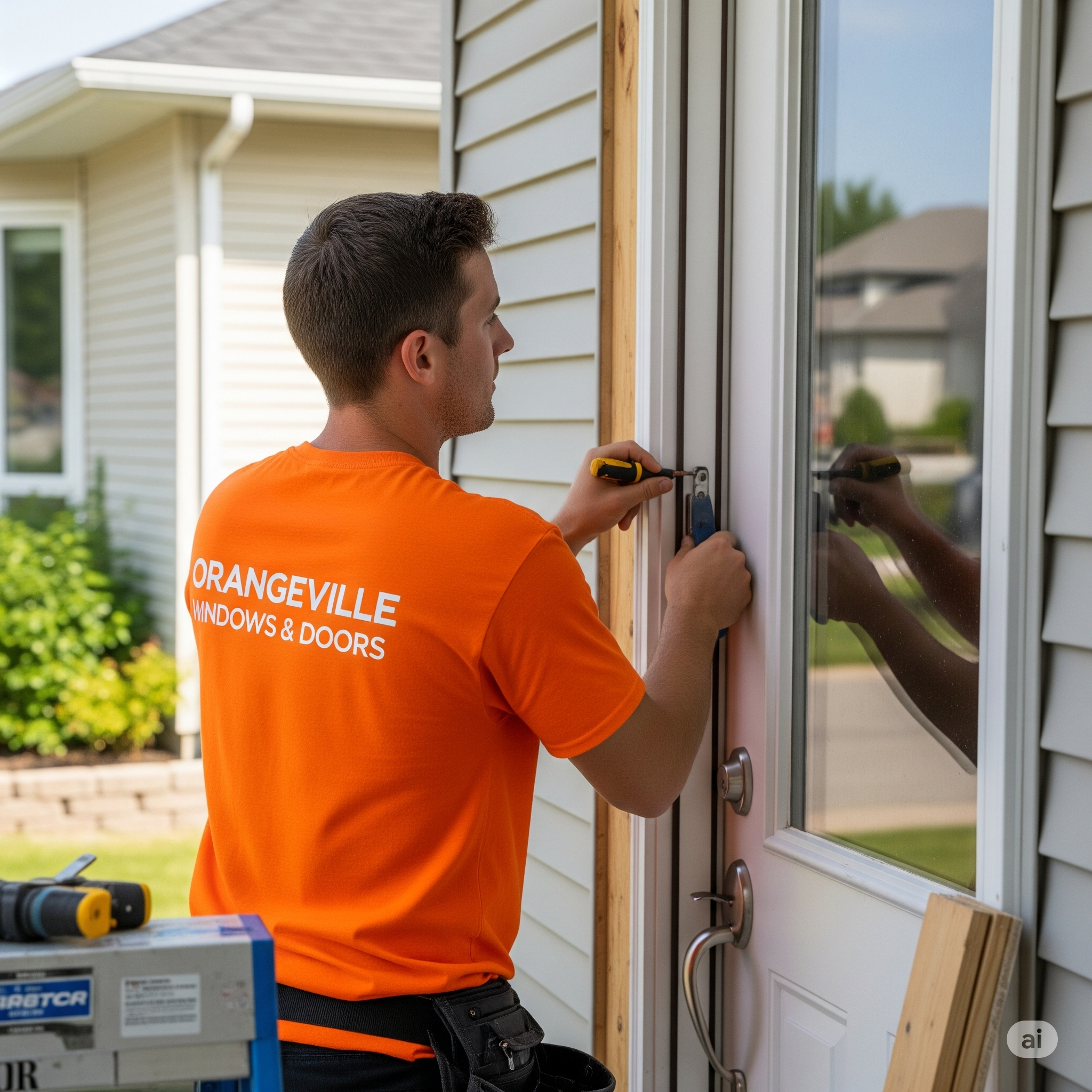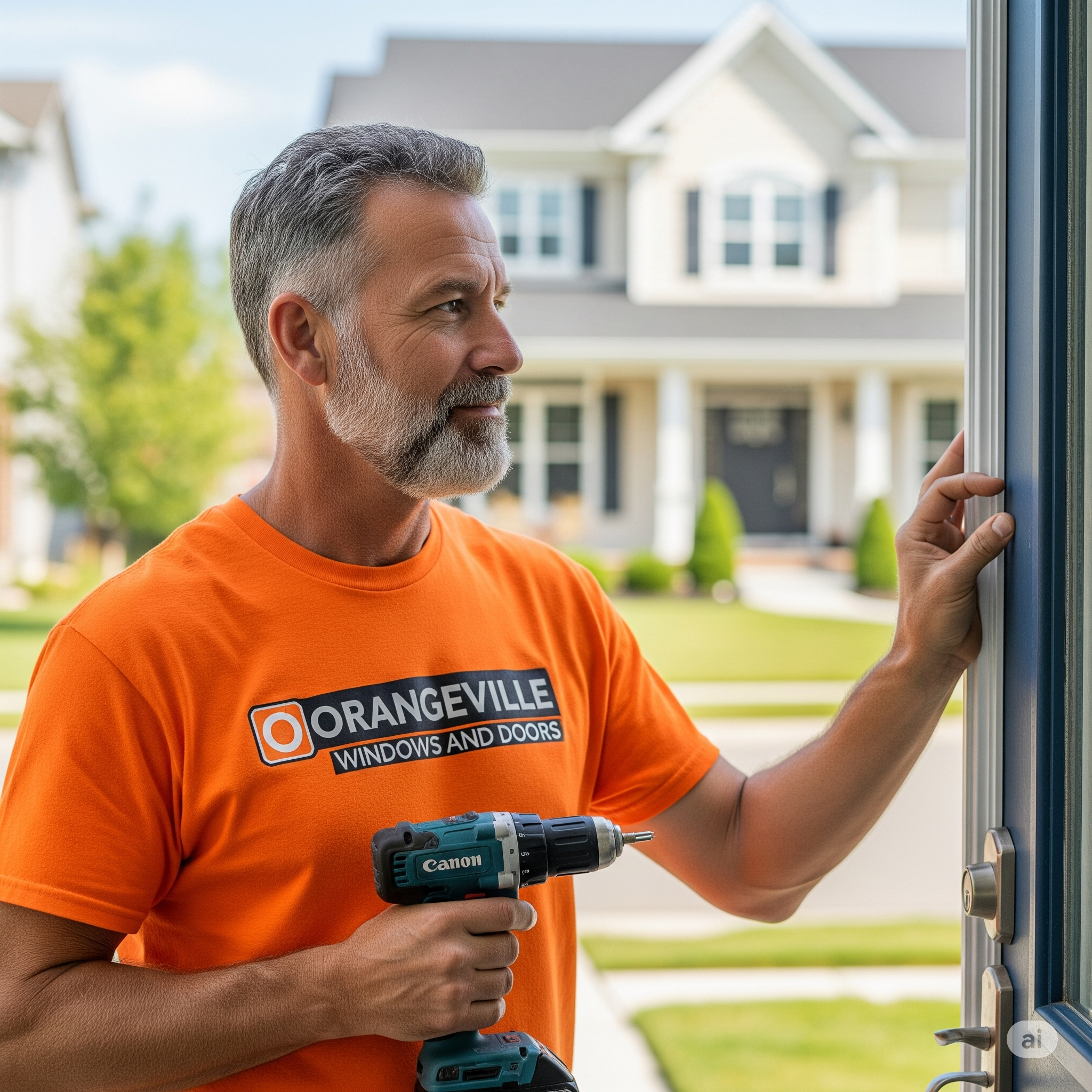Ontario winters are notoriously harsh, with temperatures plummeting well below freezing, heavy snowfall, and biting winds that can find their way into even the smallest gaps around windows and doors. As winter approaches, smart homeowners take proactive steps to ensure their homes are properly sealed and insulated to maintain comfort while controlling heating costs. At Orangeville Windows and Doors Inc., we’ve helped countless families prepare their homes for winter weather, and we’re sharing our expert knowledge to help you do the same.
Understanding Winter’s Impact on Your Home
Winter weather creates unique challenges for your home’s envelope. Temperature differentials between inside and outside can exceed 50°C, creating significant stress on windows and doors. Repeated freeze-thaw cycles cause materials to expand and contract, potentially creating gaps and compromising seals. Snow and ice accumulation can block drainage systems and create ice dams that force water into unexpected areas.
Dry winter air also affects your home’s materials. Wood components can shrink, creating gaps that weren’t present during humid summer months. Metal components contract, potentially affecting hardware alignment and operation. Understanding these seasonal changes helps you anticipate and address potential problems before they become costly issues.
Comprehensive Window Inspection and Preparation
Exterior Inspection Protocol: Begin your winter preparation by thoroughly inspecting all windows from the outside. Look for cracked or missing caulk around the window frame where it meets the siding. Check for loose or damaged weatherstripping, particularly along the bottom sill where water tends to accumulate. Examine the window glazing compound or gaskets that hold the glass in place, as these can deteriorate over time and allow air infiltration.
Pay special attention to areas where different materials meet, such as where window frames connect to brick, stone, or siding. These transition zones are particularly vulnerable to air and water infiltration. Look for any signs of previous water damage, including staining, peeling paint, or soft spots in wood components.
Interior Assessment: From inside your home, check for any visible gaps around window frames. On cold days, you can often feel air movement near poorly sealed windows. Look for condensation patterns that might indicate air leakage or inadequate insulation. Test window operation to ensure smooth opening and closing, as binding windows may indicate frame issues that could worsen during winter.
Examine window locks and hardware to ensure they engage properly and hold windows securely closed. Loose or worn hardware can allow windows to rattle in wind and may compromise the seal around the window perimeter.
Weatherstripping Solutions: Weatherstripping is your first line of defense against air infiltration, but it requires regular inspection and replacement to remain effective. Different types of weatherstripping serve different applications, and choosing the right type for each location is crucial for optimal performance.
Compression weatherstripping works well for areas where the window sash presses against the frame. This type creates a tight seal when compressed but requires proper adjustment to function effectively. Sliding weatherstripping is designed for windows that slide horizontally or vertically, providing a seal while allowing smooth operation.
For windows that cannot be easily re-weatherstripped, temporary solutions like rope caulk or foam tape can provide winter-long protection. These materials are designed to be removed in spring without damaging window finishes.
Caulking and Sealing: Quality caulking creates a permanent barrier against air and water infiltration. However, not all caulks are suitable for exterior use or extreme temperature variations. Silicone-based caulks remain flexible in cold temperatures and adhere well to most building materials. Polyurethane caulks offer excellent durability and can be painted to match your home’s exterior.
Before applying new caulk, remove all old, cracked, or loose material. Clean the area thoroughly to ensure good adhesion. Apply caulk in a continuous bead, tooling the surface to create a smooth, weather-tight seal. Pay particular attention to corners and joints where different materials meet.
Door Winterization Strategies
Threshold and Weatherstripping Maintenance: Door thresholds bear the brunt of winter weather exposure and require special attention. Adjustable thresholds should be properly adjusted to create a tight seal with the door bottom without interfering with smooth operation. Worn or damaged threshold materials should be replaced before winter to prevent drafts and water infiltration.
Door weatherstripping experiences constant wear from repeated opening and closing cycles. Inspect all weatherstripping around the door perimeter, paying special attention to high-wear areas like the latch side where the door contacts the frame. Replace any weatherstripping that shows signs of cracking, compression set, or poor adhesion.
Storm Door Benefits: Storm doors provide an additional barrier against winter weather while allowing natural light and ventilation during milder periods. Quality storm doors feature their own weatherstripping systems and create an insulating air space that improves overall thermal performance.
Modern storm doors offer features like retractable screens, adjustable closers, and impact-resistant glass that enhance both function and durability. Some models include low-E glass coatings that improve energy efficiency while maintaining visibility.
Hardware and Operation Checks: Cold weather can affect door hardware operation, particularly if moisture has infiltrated lock mechanisms or hinges. Lubricate hinges, locks, and door closers with appropriate cold-weather lubricants to ensure reliable operation throughout winter.
Test door locks to ensure they engage properly and can be operated smoothly with gloved hands. Consider upgrading to keyless entry systems if you frequently struggle with keys in cold weather.
Identifying and Addressing Air Leaks
Detection Techniques: Air leaks can be subtle but significantly impact comfort and energy efficiency. Simple detection methods include holding a lit candle or incense stick near suspected leak areas on windy days. The flame or smoke will flicker or drift toward air leaks. Alternatively, dollar bill tests can identify loose seals around doors and operable windows.
More sophisticated detection involves using infrared thermometers or thermal imaging cameras to identify temperature variations that indicate air infiltration. Professional energy audits using blower door tests can quantify air leakage and pinpoint specific problem areas.
Common Problem Areas: Certain areas are particularly prone to air leakage and deserve special attention during winter preparation. Window and door frames, electrical outlets on exterior walls, and penetrations for utilities like cable or phone lines often develop air leaks over time.
Basement windows frequently experience problems due to settling and moisture exposure. Attic access points can be major sources of air leakage if not properly sealed. Don’t overlook less obvious areas like dryer vents, exhaust fans, and recessed lighting in exterior walls.
Sealing Solutions: Different types of air leaks require different sealing approaches. Gaps around window and door frames typically respond well to caulking or expanding foam sealants. Larger gaps may require backer rod or other filler materials before caulking.
Moveable joints and areas subject to seasonal movement need flexible sealants that can accommodate expansion and contraction without cracking. Permanent sealing solutions work best for stable areas that don’t experience significant movement.
Insulation Considerations
Window Insulation Options: Temporary window insulation can provide significant energy savings during winter months. Plastic film kits create an additional air space that reduces heat loss while maintaining window visibility. These kits are particularly effective on older windows with poor thermal performance.
Cellular shades and insulated curtains provide both insulation and light control benefits. These window treatments can reduce heat loss by 10-20% when properly installed and used consistently. Some models feature sealing systems that create nearly airtight barriers when closed.
Door Insulation Strategies: Older doors often lack adequate insulation and can benefit from temporary improvements. Draft guards or door snakes block air movement under doors, while insulated curtains or panels can provide additional thermal barriers for doors with glass panels.
For doors that receive heavy use, consider investing in permanent upgrades like door sweeps, improved weatherstripping, or complete door replacement if the existing door cannot be adequately sealed.
Emergency Preparedness and Winter Maintenance
Ice Dam Prevention: Ice dams can force water behind normal weatherproofing systems, causing damage to windows, doors, and surrounding structures. Proper attic insulation and ventilation help prevent ice dam formation by maintaining consistent roof temperatures.
Keep gutters and downspouts clear of debris to ensure proper drainage. Consider installing heating cables in problem areas where ice dams frequently form. Remove snow from lower roof areas when accumulation becomes excessive.
Freeze Protection: Pipes near exterior walls or in unheated areas are vulnerable to freezing, especially if air leaks allow cold air to reach them. Sealing air leaks around windows and doors in these areas can provide important freeze protection for plumbing systems.
Cabinet doors under sinks on exterior walls should be opened during extreme cold to allow warm air circulation around pipes. Know the location of your water shut-off valve in case emergency repairs become necessary.
Maintenance Schedules: Regular winter maintenance helps prevent small problems from becoming major issues. Monthly inspections of weatherstripping and caulking allow early detection of problems when repairs are still simple and inexpensive.
Keep replacement materials on hand for common problems like loose weatherstripping or minor caulk failures. Having supplies available allows immediate repairs when problems are discovered.
Professional Services and When to Call for Help
While many winter preparation tasks can be handled by homeowners, some situations require professional expertise. Complex air leakage problems, structural issues affecting window and door operation, and major weatherproofing failures often need professional assessment and repair.
At Orangeville Windows and Doors Inc., we provide comprehensive winter preparation services for homeowners who prefer professional assistance or have issues beyond their comfort level to address. Our experienced team can quickly identify and resolve problems that might be difficult for homeowners to diagnose or repair.
Upgrade Opportunities: Winter preparation often reveals windows and doors that have reached the end of their effective service life. Rather than investing in repeated repairs, upgrading to modern, energy-efficient windows and doors can provide better long-term value and performance.
Our team can assess your current windows and doors and provide recommendations for cost-effective improvements that will enhance comfort, security, and energy efficiency for years to come.
Cost-Effective Solutions for Every Budget
Winter preparation doesn’t have to be expensive to be effective. Simple measures like adding weatherstripping, caulking gaps, and installing temporary window insulation can provide significant improvements at minimal cost. These measures often pay for themselves through reduced heating bills in a single winter.
For homeowners with larger budgets, investments in storm doors, upgraded weatherstripping systems, or window replacement can provide greater long-term benefits. Our team helps you prioritize improvements based on your budget and the potential impact on comfort and energy efficiency.
DIY vs. Professional Services: Many winter preparation tasks are well-suited for DIY completion, but some require professional expertise for optimal results. We’re happy to provide guidance on which tasks you can handle yourself and which situations warrant professional assistance.
Planning for Long-Term Performance
Effective winter preparation is part of a larger home maintenance strategy that includes regular inspections, preventive maintenance, and timely upgrades. Keeping detailed records of maintenance activities and problems helps identify patterns and plan for future improvements.
Consider creating a seasonal maintenance checklist that includes winter preparation tasks as well as other important home maintenance activities. Regular attention to your home’s envelope helps prevent major problems and extends the life of your windows and doors.
Professional Support When You Need It
At Orangeville Windows and Doors Inc., located at 283 Broadway Unit 15 in Orangeville, we’re committed to helping homeowners prepare their homes for Ontario’s challenging winters. Whether you need advice on DIY projects, professional winter preparation services, or major upgrades to improve your home’s performance, our experienced team is ready to help.
Contact us at 226-773-5009 to discuss your winter preparation needs or schedule an assessment of your windows and doors. Our expertise ensures your home will stay comfortable and efficient throughout the winter months while protecting your investment for years to come.



